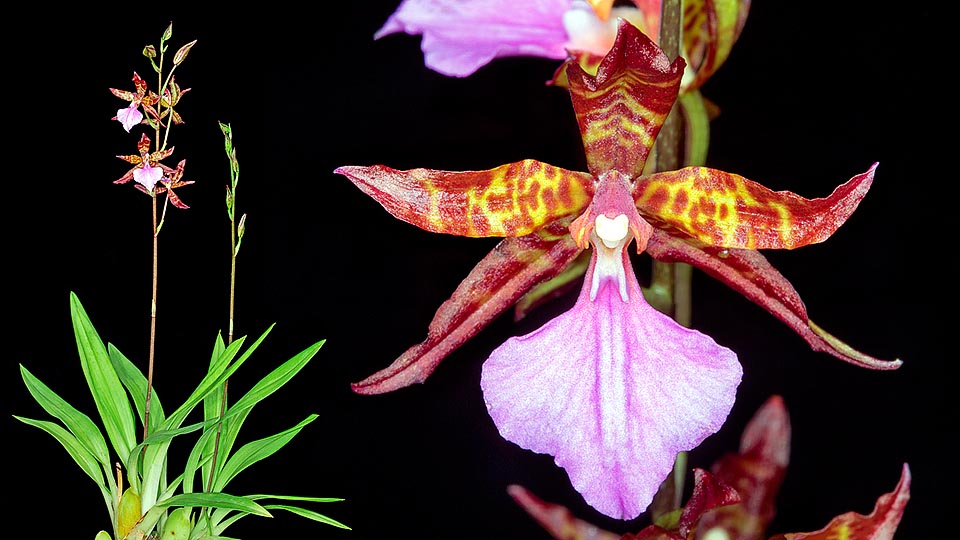Family : Orchidaceae

Text © Pietro Puccio

English translation by Mario Beltramini
The species is native to Costa Rica, El Salvador, Guatemala, Honduras, Mexico (Campeche, Chiapas, Colima, Guerrero, Jalisco, Michoacán, Nayarit, Oaxaca, Quintana Roo, Tabasco, Vera Cruz and Yucatán) and Panama where it grows in the humid forests between 1500 and 3200 m of altitude.
The generic name is the combination of the Greek terms ”ρύγχος” (rhynchos) = beak and “στήλη” (stele) = column, stele, with reference to the shape of the column; the latin name of the species “bictoniensis” = of Bicton, was given by James Bateman (1811-1897), who described it with the name Cyrtochilum bictoniense , not only in reference to the British site where it has bloomed for the first time in Europe, but also as a tribute to the owners, Lord and Lady Rolle of Bicton.
The Rhynchostele bictoniensis (Bateman) Soto Arenas & Salazar (1993) is an epiphytic or terrestrial species with short rhizome, from where originate oblong pseudobulbs, slightly compressed laterally, 5-13 cm long, provided at the base of 2-3 foliaceous bracts and at the apex of a linear-lanceolate leaf, 20-35 cm long and 2-3,5 cm broad, of pale green colour and coriaceous. Racemose Inflorescences form the base of the pseudobulbs, erect, 30-80 cm long, bearing numerous flowers gradually opening, of about 4 cm of diameter, with greenish yellow sepals and petals irregularly maculated brown red and white to purple pink labellum with at the base two fleshy lamellae, erect, white or pink. Lanceolate dorsal sepal with pointed apex, about 1,6 cm long and 0,6 cm broad, linear-lanceolate lateral sepals with pointed apex, 1,8-2 cm long and 0,6 cm broad, linear-lanceolate petals with pointed apex, about 1,6 cm long and 0,8 cm broad, ovate labellum restricted at the base with pointed apex, about 2 cm long and 1,6 cm broad, and column, about 0,7 cm long, provided on the sides of rounded wings.

Rhynchostele bictoniensis is a Central America epiphytic or terrestrial species that has originated several easy to cultivate hybrids. The racemose inflorescences, originating at the base of the pseudobulbs, are erect, even 80 cm long, with several flowers of about 4 cm of diameter opening gradually © Giuseppe Mazza
Species with decorative blooming, vigourous and of easy cultivation, being pretty tolerant towards the high temperatures, suitable also for beginners, and that has originated numerous hybrids. It requires a slightly shady position, intermediate temperatures, 18-28 °C, and high humidity, 70-80%, in summer, cool temperatures, ideal 10-18 °C with high daily temperature range and humidity around the 50-60% in winter. The waterings, with rain water, demineralized or by reverse osmosis, must be regular during the vegetative period, avoiding stagnations that may easily cause radical rotteness, almost stopped, but without ever allowing the pseudobulbs to excessively wrinkle, in winter, so to grant a period of cool and dry rest. Fortnightly fertilizations during the vegetative phase utilizing a balanced hydrosoluble product, with microelements, at ¼ the dosage shown on the package. It is usually cultivated in pots, preferably earthenware, or baskets with compost that may be formed by fine/medium sliced bark fragments, charcoal and sphagnum, with addition of inerts to improve the drainage and the aeration of the roots, that must be able to quickly dry up after each watering.
The species is reported in the appendix II of CITES (species whose trade is internationally ruled).
Synonyms: Cyrtochilum bictoniense Bateman (1838); Odontoglossum bictoniense (Bateman) Lindl. (1840); Zygopetalum africanum Hook. (1840); Odontoglossum bictoniense var. splendens Lem. (1865); Lemboglossum bictoniense (Bateman) Halb. ex Soto Arenas (1988); Amparoa bictoniensis (Bateman) Archila (2009).
→ For general notions about ORCHIDACEAE please click here.
